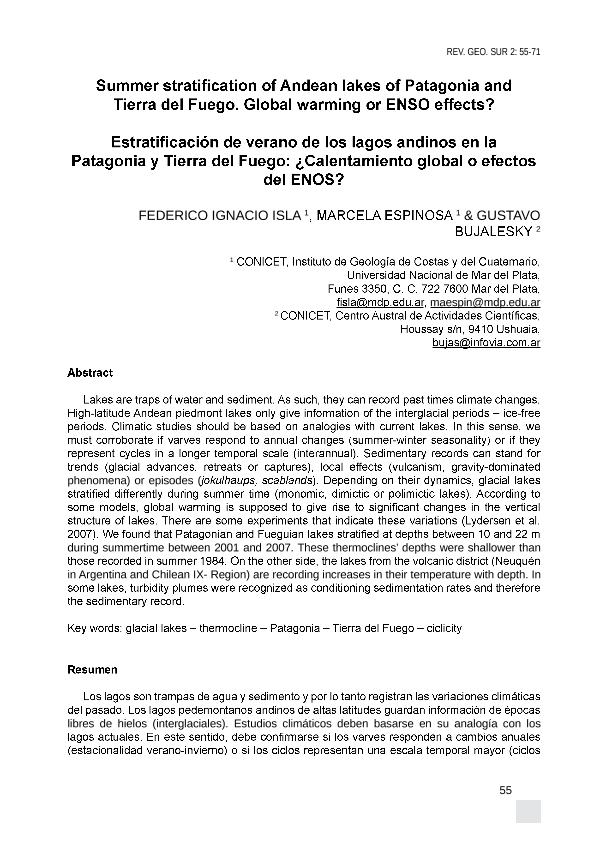Mostrar el registro sencillo del ítem
dc.contributor.author
Isla, Federico Ignacio

dc.contributor.author
Espinosa, Marcela Alcira

dc.contributor.author
Bujalesky, Gustavo Gabriel

dc.date.available
2017-02-10T15:32:17Z
dc.date.issued
2010-04
dc.identifier.citation
Isla, Federico Ignacio; Espinosa, Marcela Alcira; Bujalesky, Gustavo Gabriel; Summer Stratification of Andean Lakes of Patagonia and Tierra del Fuego. Global Warming or Enso Effects?; Universidad de Concepción. Facultad de Arquitectura, Urbanismo y Geografía. Departamento de Geografía; Revista Geográfica del Sur; 1; 2; 4-2010; 55-71
dc.identifier.uri
http://hdl.handle.net/11336/12831
dc.description.abstract
Lakes are traps of water and sediment. As such, they can record past times climate changes. High-latitude Andean piedmont lakes only give information of the interglacial periods -ice-free periods. Climatic studies should be based on analogies with current lakes. In this sense, we must corroborate if varves respond to annual changes (summer-winter seasonality) or if they represent cycles in a longer temporal scale (interannual). Sedimentary records can stand for trends (glacial advances, retreats or captures), local effects (vulcanism, gravity-dominated phenomena) or episodes Uoku/haups, scab/ands). Depending on their dynamics, glacial lakes stratified differently during summer time (monomic, dimictic or polimictic lakes). According to some models, global warming is supposed to give rise to significant changes in the vertical structure of lakes. There are some experiments that indicate these variations (Lydersen et aL 2007). We found that Patagonian and Fueguian lakes stratified at depths between 10 and 22 m during summertime between 2001 and 2007. These thermoclines' depths were shallower than those recorded in summer 1984. On the other side, the lakes from the volcanic district (Neuquen in Argentina and Chilean IX-Region) are recording increases in their temperature with depth. In some lakes, turbidity plumes were recognized as conditioning sedimentation rates and therefore the sedimentary record.
dc.format
application/pdf
dc.language.iso
spa
dc.publisher
Universidad de Concepción. Facultad de Arquitectura, Urbanismo y Geografía. Departamento de Geografía
dc.rights
info:eu-repo/semantics/openAccess
dc.rights.uri
https://creativecommons.org/licenses/by-nc-sa/2.5/ar/
dc.subject
Glacial Lakes
dc.subject
Thermocline
dc.subject
Patagonia
dc.subject
Tierra del Fuego
dc.subject
Ciclicity
dc.subject.classification
Geología

dc.subject.classification
Ciencias de la Tierra y relacionadas con el Medio Ambiente

dc.subject.classification
CIENCIAS NATURALES Y EXACTAS

dc.title
Summer Stratification of Andean Lakes of Patagonia and Tierra del Fuego. Global Warming or Enso Effects?
dc.title
Estratificación de verano de los lagos andinos en la Patagonia y Tierra del Fuego: ¿Calentamiento global o efectos del ENOS?
dc.type
info:eu-repo/semantics/article
dc.type
info:ar-repo/semantics/artículo
dc.type
info:eu-repo/semantics/publishedVersion
dc.date.updated
2017-02-07T18:02:17Z
dc.identifier.eissn
0718-7653
dc.journal.volume
1
dc.journal.number
2
dc.journal.pagination
55-71
dc.journal.pais
Chile

dc.journal.ciudad
Concepción
dc.description.fil
Fil: Isla, Federico Ignacio. Universidad Nacional de Mar del Plata. Facultad de Ciencias Exactas y Naturales. Instituto de Geología de Costas y del Cuaternario; Argentina
dc.description.fil
Fil: Espinosa, Marcela Alcira. Universidad Nacional de Mar del Plata. Facultad de Ciencias Exactas y Naturales. Instituto de Geología de Costas y del Cuaternario; Argentina
dc.description.fil
Fil: Bujalesky, Gustavo Gabriel. Consejo Nacional de Investigaciones Científicas y Técnicas. Centro Austral de Investigaciones Científicas; Argentina
dc.journal.title
Revista Geográfica del Sur
dc.relation.alternativeid
info:eu-repo/semantics/altIdentifier/url/http://www.revgeosur.udec.cl/?p=111
Archivos asociados
